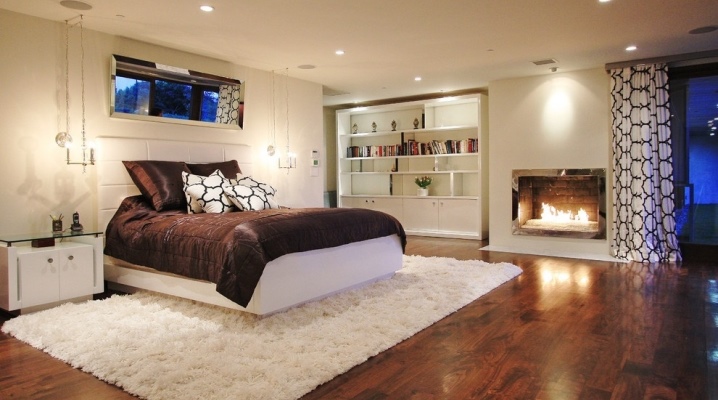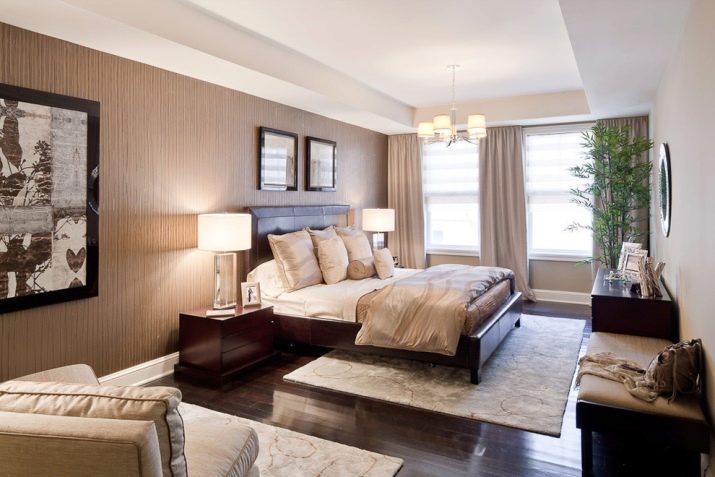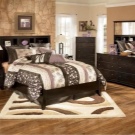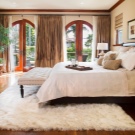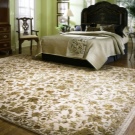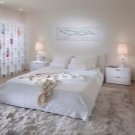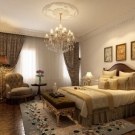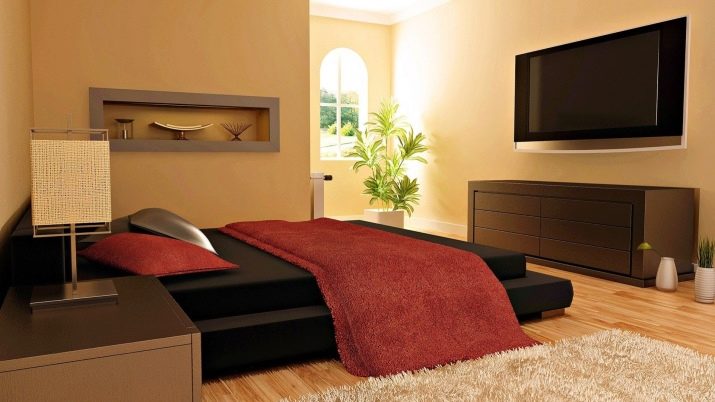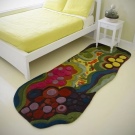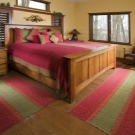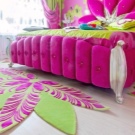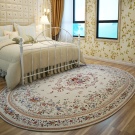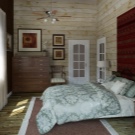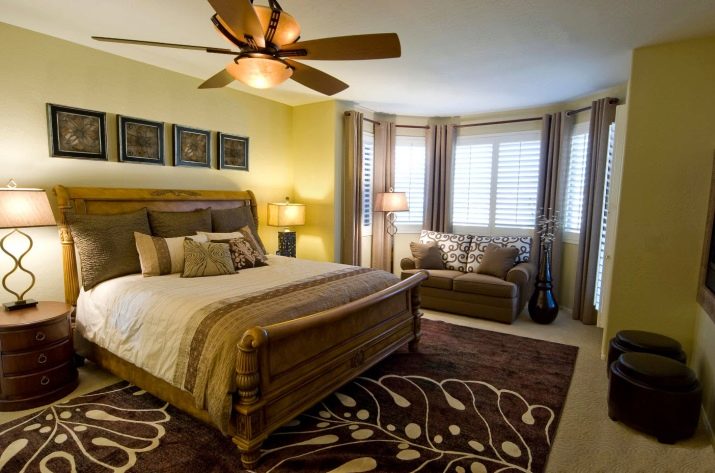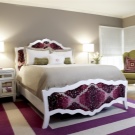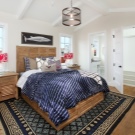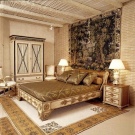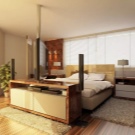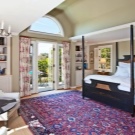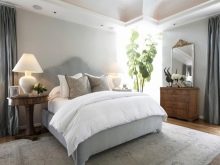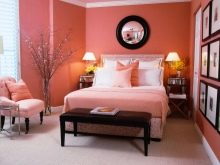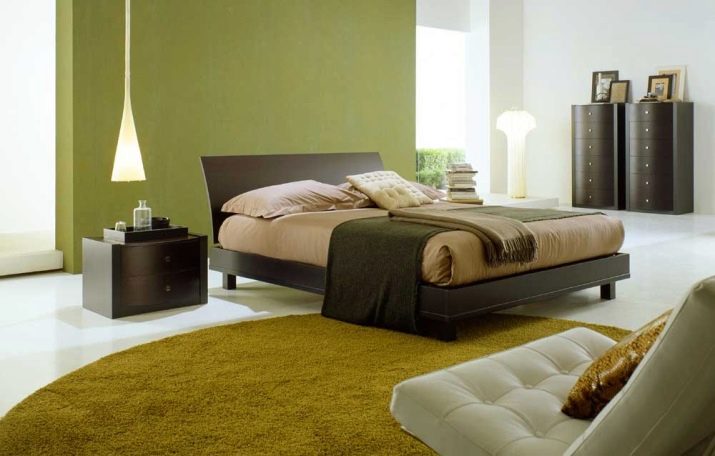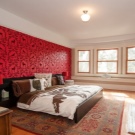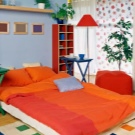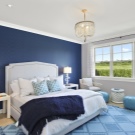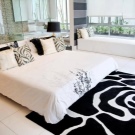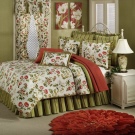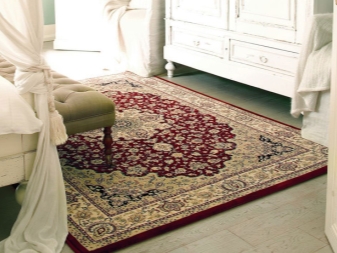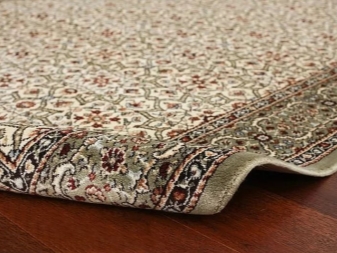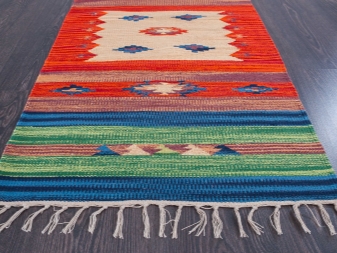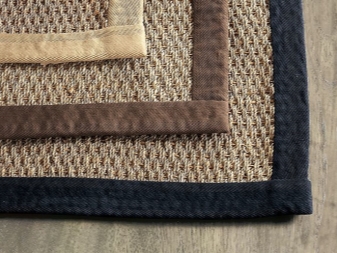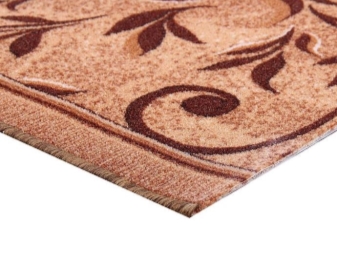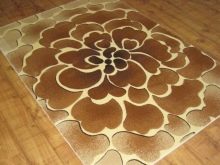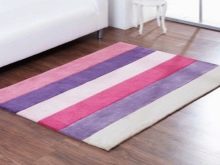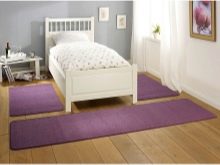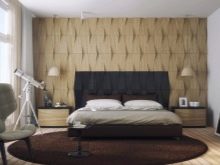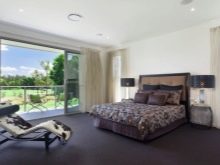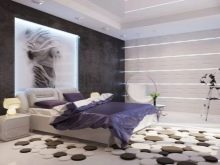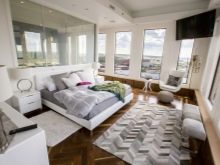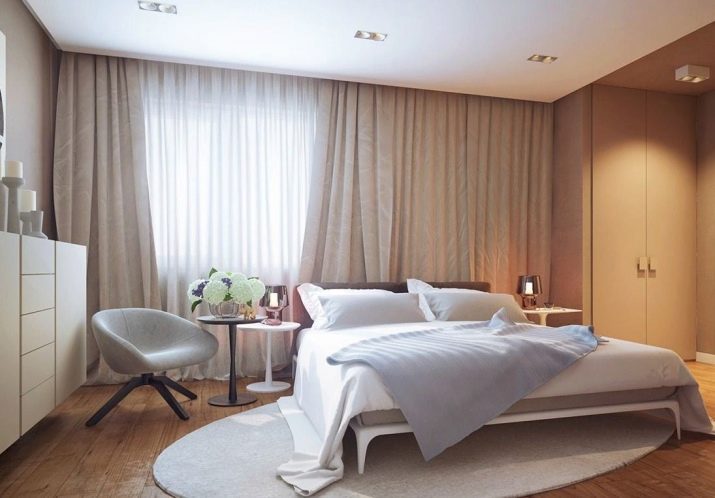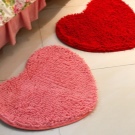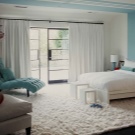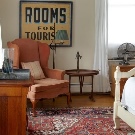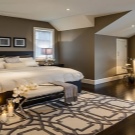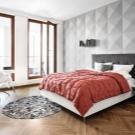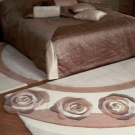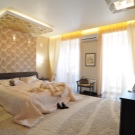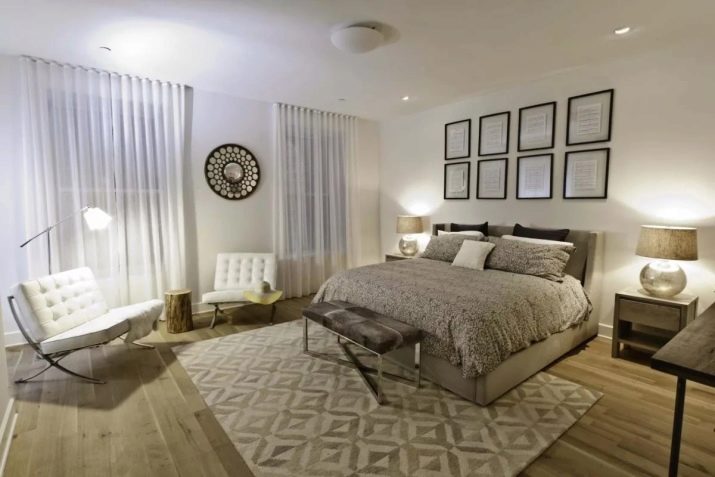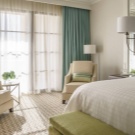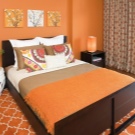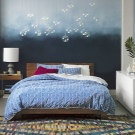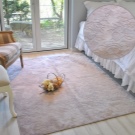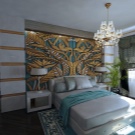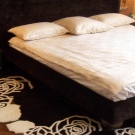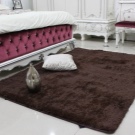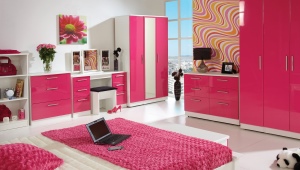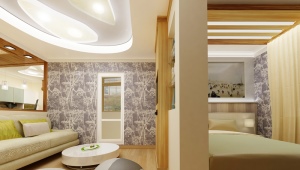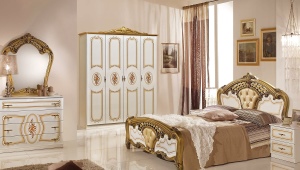Carpet in the bedroom
Many people think that the main thing in the bedroom is the bed. Wide and soft, it is she who gives the room comfort. This is not entirely true. The details on the bedside table, the curtains, and, of course, the carpet are important for the cozy atmosphere of any room.
The soft pile of the carpet in the bedroom attracts attention, it is pleasant to walk on it barefoot, with proper care you can even sit on it.
What to choose?
Carpet is a really stylish interior detail. The time has passed when carpets were considered an inconvenient attribute for floor insulation, now there are numerous options for colors, materials, forms, carpets that are suitable even for the most demanding interior.
If you go further into this topic, you can find out that carpets even have their own subtypes. For example, the track. The carpet is an elongated rectangle that can be up to a meter long or a little more. This is not the best option directly for the bedroom, because the room is almost never has a pronounced elongated shape, but it will look good in the corridor or on the stairs.If the bedroom is upright a little longer than horizontally, pay attention to asymmetrical carpets - round or skin type, which should be located just under the rear legs of the bed.
A good solution would be the choice of several small rugs with a thin pile, which are covered with overlap.
Colors
The carpet can be a bright accent in the interior of the bedroom, or be matched to the furniture or walls - it all depends on what goal you want to achieve. But in any case, you can not take the carpet from the interior of the high-tech and shove it into the Provence just to create a contrast. All items in the room should be related to each other and be of the same style. Thanks to this, the bedroom will look as harmonious as possible.
You can choose a carpet of the same color as the curtains or bedding, a lamp or a chair pouf, since these small details are also able to transform a room beyond recognition and it will be just fine if they are all made in a single color scheme.
For example, white-brown curtains, “coffee with milk” bedding and chocolate fleecy carpet.
Furniture may also be the same color as the carpet.A gray bed can stand on a gray carpet, and a chest of drawers with red legs can comfortably sit on a coral. But we are talking, rather, about approximate similarities, but not complete - the furniture should not merge with the carpet, they should differ from each other in texture, saturation of tone or pattern.
The reverse option - a noticeable carpet, contrasting. Its main task is to emphasize the color of furniture with opposite shades. For example, a black or chocolate carpet will visually whiten a white bed, and vice versa.
The only thing to remember is that white carpet and pastel shades are the most impractical. They have to be washed frequently - or taken to dry cleaning, which not only gets on my nerves, but also beats the family budget, and this process is quite time consuming.
In the same way, you can choose a carpet that contrasts with the color of the floor - milky on brown or something like that. As for the color of the walls, then the option is the opposite - a green carpet under the green walls. There is no contrast between the walls and the carpet (but may be present at the same time relative to the floor). The same feature works with long vertical curtains.
The classic scheme - a bedroom decorated in a single tone, complemented by another similar shade on the carpet.. The main thing here - do not overdo it, choose one or two similar colors for the main ones and keep clear of sharp contrast (like on a tiger, for example).
A carpet with a flower or any patterned ornament is able to bring completeness to the interior, can “liven up” the floor, and the pattern on the carpet can also overlap with patterns on other surfaces.
Materials
Silk and wool are considered the most ancient fabrics for making carpets. They are used today, are considered more than popular, but production does not stand still. Nowadays, you can find carpets of any other materials, their symbiosis and artificial substitutes.
- Wool. Costly classic. Such carpets are durable and warm, most often made from sheep wool, and the most expensive option is cashmere. It has good fire-resistant characteristics, does not spread fire. This carpet can live half a century! With proper care, of course, which is quite difficult to maintain. Wool quickly gets dirty and is also eaten by moths. Most modern manufacturers impregnate their carpets with special agents - antifouling, antifungal and dirt-repellent.You will also not find a bright woolen carpet, as wool absorbs dye worse, therefore it is more difficult to dye it. However, also the paint on it does not fade, so it will remain in ten years in due form.
- Silk. The most expensive (more expensive than wool) and the most durable carpets. They are distinguished by their characteristic brilliance and very soft to the touch. It is also silk that makes beautiful patterned carpets - its threads are thin, flexible and durable, which allows us to weave almost any patterns. Unlike wool carpets, these fade easily and are not so durable; they cannot be exposed to direct sunlight.
- Viscose. Artificial material derived from cellulose, which, in turn, is obtained from spruce or pine. And it gives the right to call viscose carpets a good alternative to natural (due to the similar appearance, the material is also called artificial silk). It very well gives in to coloring, paint from it does not wash off for a long time and does not fade. In general, viscose carpets are durable, durable, and their only drawback is that they absorb moisture and become wet, so it’s better not to spill sweet tea or red wine.
- Cotton. Cotton carpets are inexpensive, economical and non-allergic, breathable and easy to clean. However, they are prone to bruising and various types of deformations, so they may not be suitable for rooms in which there is a large flow of people.
- Jute. Jute is a shrub, therefore jute carpets are eco-friendly, and besides, they are also inexpensive and durable. The only thing is that when moisture gets in, the jute settles.
- Polyamide. A very popular synthetic material in modern carpet production. This is synthetic, which is why such carpets shine so beautifully, shimmer and such elastic. They accept paint well and hold pictures, do not fade, dry quickly and do not shrink. However, over time they become hard and brittle, electrified.
- Polypropylene. The most careless in care (literally just walking with a vacuum cleaner), since the polypropylene thread has a smooth structure. Despite this, polypropylene carpets are non-wear-resistant and short-lived - they have lived for only five years, not more.
- Hit set. Material from a sort of polypropylene, but having polar opposite properties. For example, it is initially antistatic, and additionally treated with anti-mud and antiseptic agents. From the properties of emit strength and lightness, these carpets do not eat away the mole and microorganisms.Hit-set - inexpensive material. Among the shortcomings - these carpets most easily catch fire and lose their shape, crumpling.
- Polyester. This is a synthetic analogue of wool, in fact - acrylic, and very similar to it in its appearance. The material itself is soft and light, inexpensive and easy to clean, which makes acrylic carpets quite a good option for the home. It is electrified, this is a drawback, but given the fact that the polyester is fire resistant and does not fade in the sun, it is a trifle.
Dimensions
Depending on the size of the bedroom is chosen and the size of the carpet. As a rule, they are divided by size in the following way:
- Little ones carpets whose area does not exceed three square meters.
- Averagetheir area is three to six square meters.
- Large carpets - from six square meters and more.
Large carpets with a length or width of more than 2.5 meters attract the eye, so it is desirable that they be calm colors and without patterns. As a rule, they are located under all the furniture in the room - under the bed as well, it will be very nice to walk barefoot on such a carpet in the morning.
Medium carpets perfectly emphasize some specific area - a mirror with a chest of drawers, for example, while small ones play the role of color contrasts. With their help, it is possible to highlight the necessary colors in the bedroom.
If you are not strong in numbers, and find out what size and shape the carpet will eventually be, then a long centimeter will come to your aid. You can lay out the contour of the future carpet and spite the resulting figures. This will not only help you decide on the size, but also understand whether this form is suitable for your bedroom.
By the way, handmade carpets are considered the most expensive, and the larger their size, the higher the price.
The form
The classic carpet shape is rectangle or square. Carpets of other forms are used more likely to place an accent in the interior - color or uniform. For example, oval rugs perfectly emphasize the area with a mirror, a large square carpet can lie near the bed, and a long, elongated carpet path will lead to the bedroom.
Moreover, carpets can specifically emphasize any one piece of furniture - to repeat the shape of a corner sofa or the same table. The only negative - in this case in the future you will need to pick up furniture under the carpet, and not vice versa.
Special mention are the carpets of the original forms - elongated drop, for example, or the skin of a bear.
How to properly arrange?
Remember a few important rules about how carpets are arranged in the interior, based on their color, shape and functionality:
- Light coloured (white, pastel shades) carpet visually increases the space. Favorably looks in monochromatic small rooms in which there is not enough light or furniture.
- Cool shades (from gray to green spectrum) create a feeling of tranquility, adjust to sleep or working mode. When the look slides over such icy shades, it doesn’t cling to anything, so a person can concentrate on his affairs. A good option for the working bedroom or for people who have trouble sleeping or concentrating.
- Warm shades, on the contrary, evoke passion, a storm of emotions. It’s easy to overdo them - a bright red carpet in orange tones will look more vulgar than beautiful. However, it is warm colors that can drastically change the mood of a room — a carpet of this color will add color and light.
- Diaper fabric can always be distinguished by one leading shade. - The background or color of the largest elements. This color can correspond to a sofa, walls, floor or curtains in the room, the second color - small details, patterns on the curtains or pillows on the sofa, flowers in a vase or a picture on the wall.Some colors can be left solo, not underlining them.
- Exists two universal options for the location of the carpet in the room. The first is when there are only rear or front legs of furniture on the carpet, and a table or chest of drawers is located in the center of the carpet. Thus the room is zoned. And the second - when all the legs of the bed are located on the carpet. Then between the carpet and the walls you need to leave at least forty centimeters of space.
- If you need to stretch the room horizontally, refer to skins or asymmetric carpets and arrange them vertically, touching only one pair of legs.
- On a fluffy carpet or a long nap carpet Do not put a bed or table with wide and flat legs. They leave scuff marks on the pile. In this case, or pay attention to the bed with thin legs or a few fluffy rugs that you place around the perimeter of the bed, and not under it.
We offer you to read useful tips on choosing a carpet in the next video.
